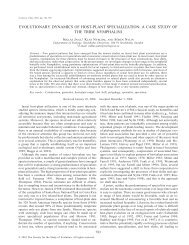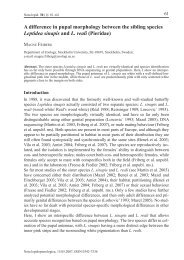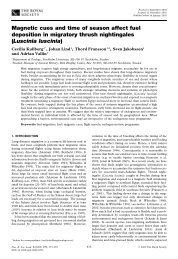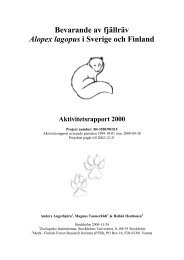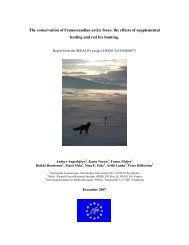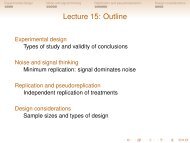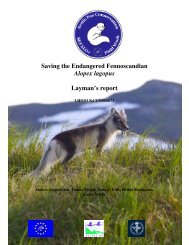Evolution of Fighting Behaviour: The Effect of Variation in Resource ...
Evolution of Fighting Behaviour: The Effect of Variation in Resource ...
Evolution of Fighting Behaviour: The Effect of Variation in Resource ...
You also want an ePaper? Increase the reach of your titles
YUMPU automatically turns print PDFs into web optimized ePapers that Google loves.
200 M. ENQUIST AND O, LEIMAR<strong>in</strong>creases when resource value <strong>in</strong>creases. <strong>The</strong> studies <strong>in</strong> Table 1 also show that whenthe subjective resource value <strong>of</strong> one <strong>of</strong> the contestants <strong>in</strong>creases (without a similar<strong>in</strong>crease for the opponent) then that <strong>in</strong>dividual will w<strong>in</strong> more <strong>of</strong>ten.<strong>The</strong> model <strong>of</strong> owner-<strong>in</strong>truder conflicts with an <strong>in</strong>formation asymmetry presented<strong>in</strong> the previous section yeilded four predictions. Several studies <strong>of</strong> contests with an<strong>in</strong>formation asymmetry between owner and <strong>in</strong>truder support these predictions (thesestudies are also <strong>in</strong>cluded <strong>in</strong> Table 1).Rand & Rand (1976) studied female iguanas compet<strong>in</strong>g for nest<strong>in</strong>g burrows, asituation <strong>in</strong> which the owner was likely to be better <strong>in</strong>formed about the value <strong>of</strong>the resource than the <strong>in</strong>truder. <strong>The</strong>y showed that the <strong>in</strong>truder's probability <strong>of</strong> w<strong>in</strong>n<strong>in</strong>gdecl<strong>in</strong>ed with resource value (prediction (i)) and that the resident's choice <strong>of</strong> actionwas related to the resource value but the <strong>in</strong>truder's was not.In Riechert's (1979, 1984) study <strong>of</strong> competition for web sites <strong>in</strong> the funnel-webspider, an owner was better <strong>in</strong>formed than an <strong>in</strong>truder about the quality <strong>of</strong> theweb-site, i.e., the rate at which suitable prey arrive at the site. Her results agreedwith predictions (i), (ii), and (iii).Sigurj6nsd6ttir & Parker (1981) studied fights between male dungflies, where achalleng<strong>in</strong>g male attempted to displace a copulat<strong>in</strong>g male. A copulat<strong>in</strong>g male seemedable to estimate how many eggs rema<strong>in</strong>ed to be fertilized (resource value) at thetime .<strong>of</strong> the struggle, and adjusted his behaviour accord<strong>in</strong>g. <strong>The</strong> results supportedpredictions (i), (ii), and (iv). This study is <strong>in</strong>terest<strong>in</strong>g s<strong>in</strong>ce there was also anotherfactor <strong>in</strong>fluenc<strong>in</strong>g resource value, namely the total number <strong>of</strong> eggs produced by thefemale. <strong>The</strong> total number <strong>of</strong> eggs is correlated with female body size, and this<strong>in</strong>formation is available to the challenger as well as to the paired male. <strong>The</strong> studyshowed that the owner's probability <strong>of</strong> w<strong>in</strong>n<strong>in</strong>g decreased with female size. Thisresult may <strong>in</strong> part be due to effects <strong>of</strong> female size on the owners positional advantage,but the <strong>in</strong>formational situation could also lead to more takeovers <strong>of</strong> bigger females(cf. Fig. 4).Austad (1983) studied the bowl and doily spider <strong>in</strong> a situation where a challeng<strong>in</strong>gmale tried to displace a copulat<strong>in</strong>g male. An owner seemed to use the time he hadbeen mat<strong>in</strong>g with the female to estimate how many eggs were left to be fertilized(resource value), but the <strong>in</strong>truder did not have this <strong>in</strong>formation. Austad's resultssupport predictions (i) and (iii).We thank Anthony Arak, Bj6rn Forkman, and an anonymous reviewer for comments onthe manuscript. This research was supported by grants from the Swedish Natural ScienceResearch Council and the Bank <strong>of</strong> Sweden Tercentenary Foundation.REFERENCESAUSTAD, S. N. (1983). A game theoretical <strong>in</strong>terpretation <strong>of</strong> male combat <strong>in</strong> the bowl and doily spider( Front<strong>in</strong>ella pyramitela). Anita. Behav. 31, 59.BARNARD, C. J. & BROWN, C. A. J. (1984). A payotI asymmetry <strong>in</strong> resident resident disputes betweenshrews. Anita. Behav. 32, 302.BISHOP, D. T., CANNINGS, C. & MAYNARD SMITH, J. (1978). <strong>The</strong> war <strong>of</strong> attrition with random rewards.J. theor. Biol. 74, 377.



